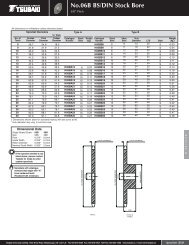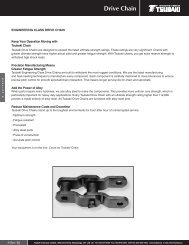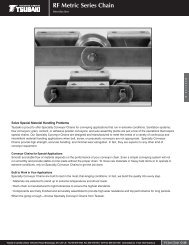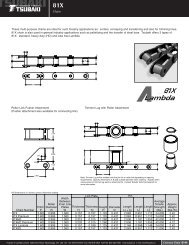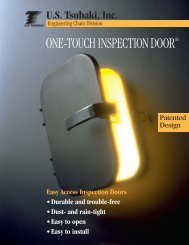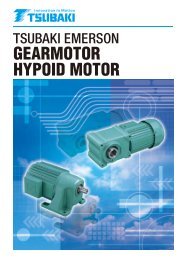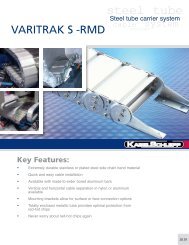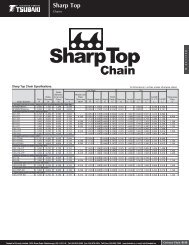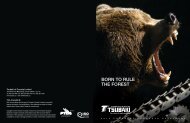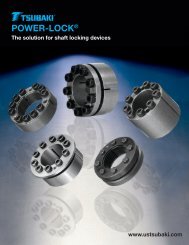Roller Chain - Tsubaki
Roller Chain - Tsubaki
Roller Chain - Tsubaki
You also want an ePaper? Increase the reach of your titles
YUMPU automatically turns print PDFs into web optimized ePapers that Google loves.
British Standard/DIN <strong>Chain</strong>Drive SelectionSELECTION PROCEDURENumber of Pitches of <strong>Chain</strong>Drive <strong>Chain</strong>1) The following factors must be considered when selecting rollerchains for transmission needs.• The power to be transmitted.• The speed and the diameters of the driving shaft and thedriven shaft.• The distance between the centers of the shafts.2) Use Table I to obtain the “service factor”.(The “Service Factor” table refers to the type of machine andsource of power.)3) Multiply the HP value by the service factor to obtain the designHP value.4) Use Table III page A-67 to obtain the appropriate chain numberand the number of teeth of the small sprocket by referring tothe number of revolutions of the high speed shaft (the drivingshaft when the speed is reduced; the driven shaft when thespeed is increased) and the design HP value. For a smootherchain drive, a smaller pitch chain is suggested. If a singlestrand chain does not satisfy the transmission requirements,use a multi-strand chain. If the distance between the shafts andthe diameter of the sprockets must be relatively small due tospace considerations, a multiple strand roller chain with asmaller pitch may be used.5) After determining the number of teeth for the small sprockets,confirm if the sprocket will meet the shaft diameterrequirements.N 2 –N 1L=N 1 +N 2+2C+6.282 CAny fraction of L is counted as one pitchCenter Distance in Pitches√18C= 2L–N 1 –N 2( ) 2+ (2L–N 1 –N 2 ) 2 – (N 2 –N 1 ) 2L: Number of pitches of chainN1: Number of teeth (small sprocket)N2: Number of teeth (large sprocket)C: Center distance in pitches<strong>Chain</strong> SpeedS=P • N • n(ft./min.)12S: <strong>Chain</strong> speed (ft./min.)P: <strong>Chain</strong> pitch (inch)N: Number of teeth of sprocketn: rpm of the sprocket<strong>Chain</strong> Tension from HP{89.86}6) The number of teeth for the large sprocket is determined bymultiplying the number of teeth for the small sprocket by thespeed ratio. While it is preferable that the number of teeth forthe small sprocket be greater than 15, it is suggested that thenumber of teeth for the large sprocket not exceed 120. Byreducing the number of teeth for the small sprocket the numberof teeth for the large sprocket can also be reduced.T=33,000 X HP(lbs.)ST: <strong>Chain</strong> tension (lbs.)Table II: Multiple Strand FactorNumber of <strong>Roller</strong><strong>Chain</strong> StrandMultiple-StrandFactorDouble Strand 1.7Triple Strand2.5Table I: Service FactorType of ImpactSmoothMachinesBelt conveyors with small load fluctuation, chain conveyors,centrifugal blowers, ordinary textile machines, ordinary machineswith small load fluctuation.ElectricMotor orTurbine1.0Source of PowerInternal Combustion EngineWith hydraulic Without hydraulicdrivedrive1.01.2Some impactCentrifugal compressors, marine engines, conveyors with some loadfluctuation, automatic furnaces, dryers, pulverizers, general machinetools, compressors, general work machines, general paper mills.1.31.21.4Large impactPresses, construction or mining machines, vibration machines, oil wellrigs, rubber mixers, general machines with reverse or impact load.1.51.41.7A-66



